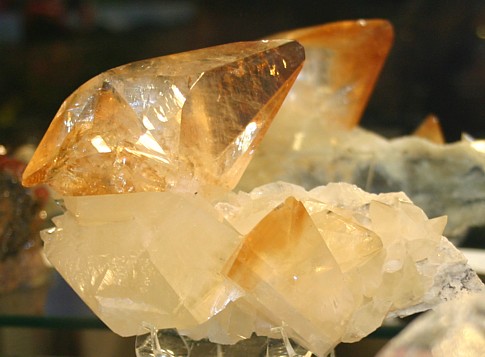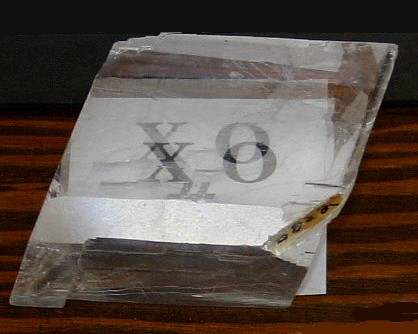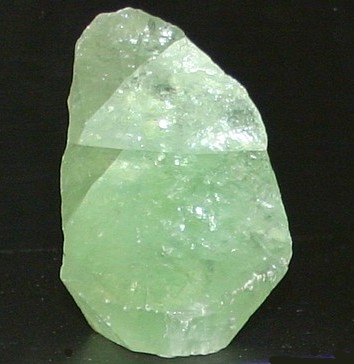|
.
Calcite Mineral Facts:
Chemical
Formula: CaCO3
Colors:
Colorless and when pure, but often
colored by impurities.
May be variously tinted,
gray, red, green, blue, yellow,
or even brown to black
when very impure
Hardness:
3.0
Density:
2.72
The density
is average for most minerals.
Cleavage:
Perfect
cleavage parallel to unit rhombohedron (angle of rhombohedron = 105 and
75). The
cleavage of calcite is so perfect
that
crystals when shattered by a hammer blow usually break into perfect
little rhombohedrons.
Crystallography: Hexagonal - Rhobohedral
Crystals are very varied in habit, often highly complex.
Crystals may be
granular, coarse to fine. Also fine-grained to compact, earthy. In
stalactitic forms, etc.
Luster:.
Vitreous to earthy.
Optics:
(Refractive Index):
Transparent to opaque.
RI: w = 1.658; E = 1.486; Strong Double Refraction
|
 |
|
| |
|
Composition,
Structure and Associated Minerals:
Calcite is
one of the most beautifully crystallized minerals known. Its crystals are
very common, and sometimes very large. They are usually colorless, though
sometimes colored, and are nearly always transparent. Besides occurring in
crystals the mineral is often found massive, in granular aggregates, in
stalactites, in pulverulent masses, in radial groupings, in fibrous masses
and in a variety of other forms. As calcite is soluble in water containing
CO2, it has often been found in pseudomorphs after other minerals. The forms
that have been observed on calcite crystals are arranged in such a manner as
to produce three distinct types of habit, as follows: (1) the rhombohedral
type, bounded by the flat rhombohedrons and often blunt scalenohedrons, (2)
the prismatic type, with the prism predominating as the principal
termination; and (3) dog-tooth spar, containing the same scalenohedrons as
on the first type mentioned above with other steeper ones and small steep
rhombohedral planes. Nail-head spar contains the flat rhombohedron with the
prism. Some of the
crystals are very complicated, belonging to no one of the distinct types
described above, but forming barrel-shaped or almost round bodies. Over 300
well established forms have been identified on them. Twined forms are
common.
Theoretically, calcite contains 56
per cent CaO and 44 per cent CO2, but practically the mineral contains also
small quantities of Mg, Fe, Mn, Zn and Pb, metals whose carbonates are
isomorphous with Calcite. It is a very poor conductor of electricity.
The principal varieties of the mineral to which distinct
names have been given are:
Iceland spar, the transparent variety used in the manufacture of optical
instruments.
Satin spar, a fine, fibrous variety with a satiny luster.
Limestone, granular aggregates occurring as rock masses and beds.
Marble, a crystalline metmorphosed limestone, with interlocking crystals.
Stalactites, cylinders or cones of calcite that hang from the roofs of
caves. They are formed by the evaporation of dripping water.
Stalagmites, corresponding cones on the floors of caves beneath the
stalactites.
Mexican onyx, banded crystalline calcite, often translucent.
Travertine, a deposit of white or yellow porous calcite produced in springs
or rivers. |

Calcite, Fine Crystals |
|
|
|
|
Identification and Diagnostics
In the closed
tube calcite often decrepitates. Before the blowpipe it is infusible. It
colors the flame reddish yellow and after heating reacts alkaline toward
moistened litmus paper. The mineral dissolves with evolution of CO2 in cold
hydrochloric acid.
Concentrated solution of the mineral dissolved in HCl gives precipitate
of calcium sulfate when a few drops of sulfuric acid are added; no
precipitate will form if solution is dilute. Its dissociation temperature
at normal
pressures is 898, though it begins to lose CO2 before that point. The
reaction with HC1, together with the alkalinity of the mineral after
heating, softness (3), its perfect cleavage, light color, vitreous luster,
etc.
distinguish calcite from all other minerals. Distinguished from dolomite by
the fact that fragments of calcite effervesce freely in cold hydrochloric
acid, while those of dolomite do not.
Occurrence,
Localities and Origins:
Calcite is
one of the most common and widely diffused of minerals. It occurs as
enormous and widespread sedimentary rock masses, in which it is the
predominant, at times practically the only mineral present. Such rocks are
the limestones, marbles (metamorphosed limestones), chalks, calcareous
marls, calcareous sandstones, etc. Its principal methods of origin are
precipitation from solutions, the weathering of calcareous minerals, and
secretion by organisms. Calcite commonly forms pseudomorphs after many
different minerals and the hard parts of animals. It occurs as a secondary
mineral in igneous rocks as a product of decomposition of lime silicates. It
is found lining the amygdaloidal cavities in lavas. It occurs in many
sedimentary and metamorphic rocks in greater or less proportion. It is the
cementing material in the light colored sandstones. Calcite is also one of
the most common of vein minerals, occurring as a gangue material, with all
sorts of metallic ores. |

Calcite is doubly refractive, splitting light in two. |
|
|
|
|
It would be quite impossible to specify all of the important districts for
the occurrence of calcite in its various forms. Some of the more notable
localities in which finely crystallized calcite is found are as follows:
Andreasberg in the Harz Mountains; Freiberg, Schneeberg and other places in
Saxony; in Cumberland, Derbyshire, Devonshire, Matlock, Lancashire and the
mines of Cornwall, England; Iceland; Guanajuato, Mexico; Keweenaw Point and
the Lake Superior copper district, Mich.; the zinc regions of Illinois,
Wisconsin and Missouri - especially Joplin, Missouri; Lake; Lockport and
Rossie in New York, Nova Scotia, etc. Iceland spar is obtained in the
Eskefjord and the Breitifjord in Iceland. Travertine is deposited from the
waters of the Mammoth Hot Springs, Yellowstone National Park. It occurs also
along the River Arno, near Tivoli, Rome.
Calcite has many important uses. In
the form of Iceland spar, on account of its strong double refraction, it is
employed in optical instruments for the production of polarized light.
Calcite rocks are used as building and ornamental stones. Marbles are used
very extensively as ornamental and building material. The most important
marble quarries in the United States are found in Vermont, New York,
Georgia, Tennessee, etc. Calcite is also employed as fluxes in
smelting operations, as one of the ingredients in glass-making and in the
manufacture of lime, and certain ground improving fertilizers. The most
important use for calcite is for the manufacture of lime for mortars and
cements. Limestone when heated to about 1000 F. loses its carbonic acid, and
is converted into quicklime, CaO. This, when mixed with water (staked lime),
swells, gives off much heat, and finally by absorption of carbon dioxide
from the air hardens, or, as commonly termed, "sets." The chemistry of the
process of their hardening is not fully understood, but various silicates of
calcium and aluminium are probably formed.
Return to the
Mineral Collectors Information Page |

Green calcite, showing cleavage lines |
|
|
|
|
|




